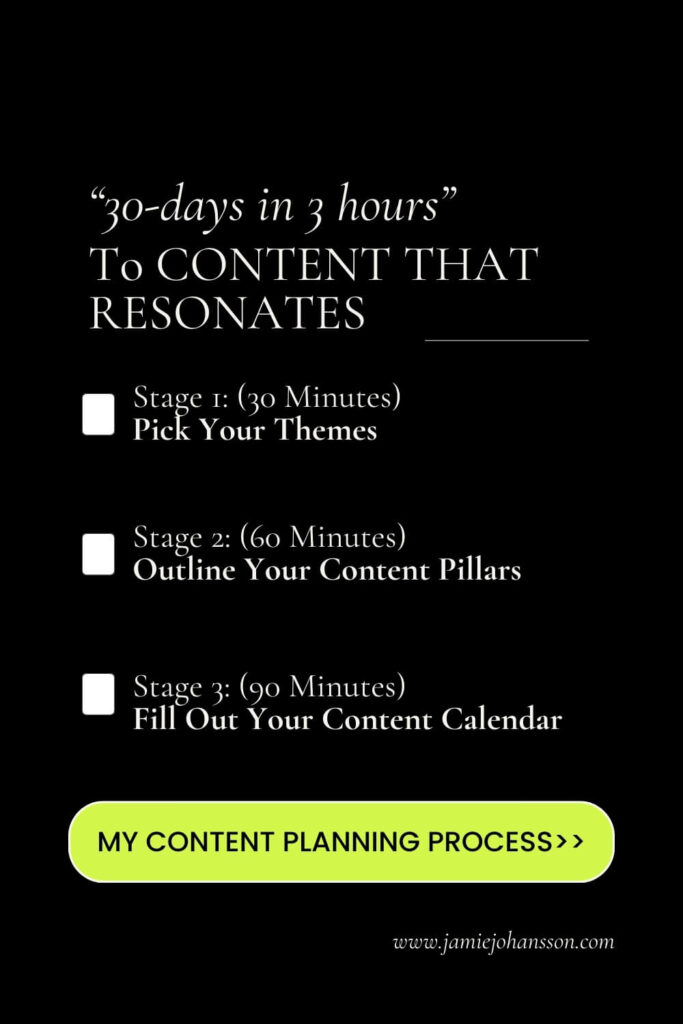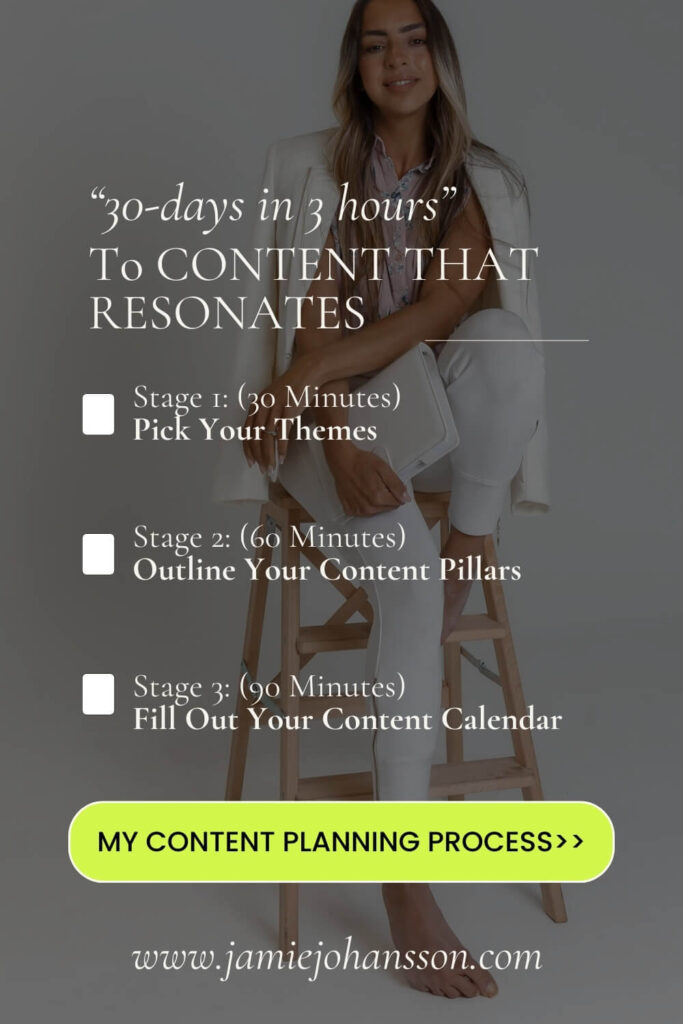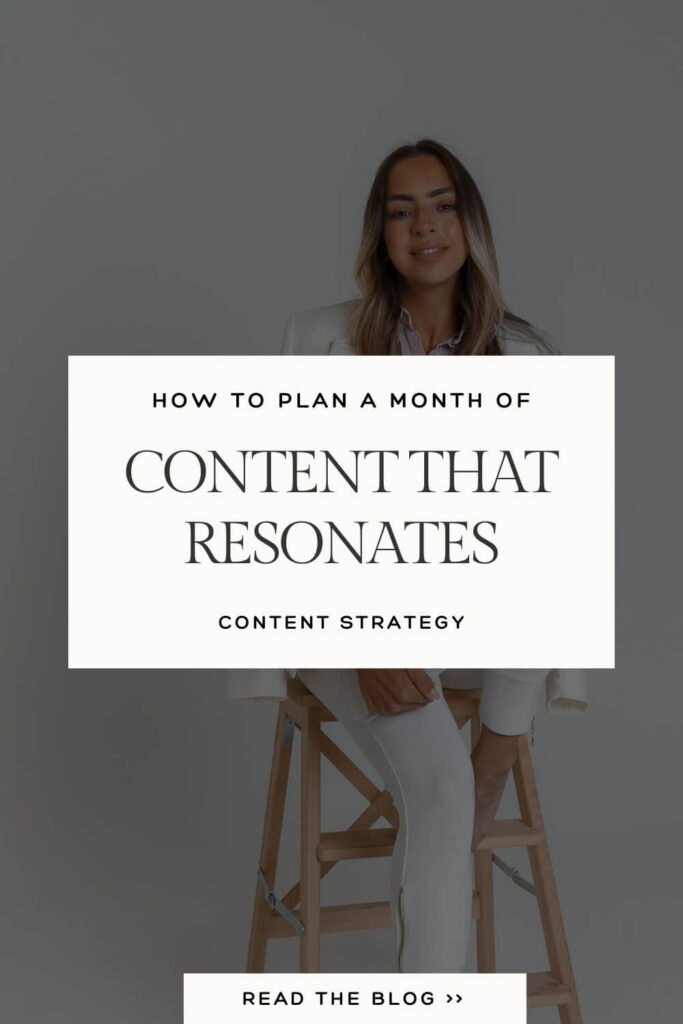Do you dread content planning each month? Let’s simplify your process with a quick and effective 3-step system that lets you batch content for the whole month in just a few hours.
Why Content Planning Feels Hard
Is this you, too? it’s Monday morning, and you’re armed with a fresh cup of brown-sugar-instant-coffee-milk-frother beverage and a notebook full of ideas.
Your goal? Plan a month’s worth of content.

But after 30 minutes, you’re staring at a blank screen, wondering where to start. You know planning is important, but somehow, it feels like a massive undertaking.
When you’re juggling multiple roles as a business owner, content planning can easily become overwhelming. It can feel like running on a hamster wheel—never-ending, time-consuming, and mostly just draining. But I’ve got good news: it doesn’t have to be this way.
Through trial, error, and a lot of caffeine, I’ve developed what I call the “Three-Hour Content Planning Rule.”
With this system, you’ll map out your content in just a few focused hours, freeing you up to work on other aspects of your business—or simply enjoy some well-deserved downtime.

Stage 1: Pick Your Themes (30 Minutes)
Start with a strong foundation by choosing three main themes for the month.
The Power of Themes
Themes are like the roadmap for your content strategy. Instead of scrambling to come up with new ideas each week, you’re working from a well-defined framework that ties directly to your business goals and audience needs. (If you’ve taken the Creative Content Fix workshop, you know this is where content goes from good, to just-hits-different!).
This means that every piece of content is purposeful and aligned with what you’re aiming to achieve this month.
To make this process even more efficient, take a look at your upcoming promotions, product launches, or special events. Are you prepping for a new workshop or launching a course? Choose themes that align with these goals so that your content naturally supports your business objectives.
For example, let’s say you’re gearing up for a workshop on content batching (like my Creative Content Fix Workshop). Your themes could look something like this:
- Content Batching: Explain what batching is, why it’s effective, and how it saves time.
- Time Management: Share strategies for getting more done in less time, essential for any busy entrepreneur.
- Marketing Strategy: Demonstrate how a well-planned content calendar directly impacts your overall marketing success.
Choosing themes doesn’t just save you time; it also helps keep your messaging consistent. By focusing on themes, you’ll ensure that each piece of content speaks directly to your audience’s needs and guides them toward your offers.
Action Step:
Set a timer for 30 minutes. Brainstorm three main themes for the month that align with your business goals and upcoming offers. Write them down, and make sure they’re broad enough to encompass multiple pieces of content but specific enough to remain relevant to your audience.

Stage 2: Outline Your Content Pillars (60 Minutes)
Once you have your themes, you’ll break them down into specific pillar content.
Content Pillars Explained
Think of content pillars as the tentpoles holding up your content strategy. They’re the big ideas that guide your content creation, helping you stay on message and build authority within your niche.
These are the core topics you want to address each week, and they’re what your audience will start to associate with you.
Imagine each theme as a category, and within each category, you’ll develop three or more specific content ideas. Here’s how this could look based on the themes we outlined earlier:
Theme: Content Batching
- Pillar 1: How to Batch Social Media Content in a Few Hours
- Pillar 2: Using Content Batching to Save Time and Avoid Burnout
- Pillar 3: Top Tools for Streamlining Your Content Creation Process
Once you have your content pillars mapped out, you can repurpose each idea across different platforms.
For instance, your blog post on “How to Batch Social Media Content in a Few Hours” could be turned into a podcast episode, a video for YouTube, or even broken down into several social media posts.
How Content Pillars Save You Time
With well-defined content pillars, you won’t be scrambling to come up with fresh ideas each week.
Instead, you have a clear structure that not only makes content planning faster but also allows you to dive deeper into each topic, positioning yourself as an authority in your niche.
Think of this as setting the stage for a month of content that flows, all while keeping your core message front and center.
Action Step:
Spend an hour outlining three content ideas for each theme. You should end up with nine specific content pieces.
These will serve as the backbone of your content for the month. Write down each piece, along with a quick outline of key points you want to cover.

Stage 3: Fill Out Your Content Calendar (90 Minutes)
Now that you have your content pillars, it’s time to plug them into a calendar.
A calendar is the secret weapon that turns your content ideas into actionable steps. But you don’t need fancy tools to make this work.
(I rely on Google Sheets because it’s simple, easy to update, and accessible from anywhere!).
Here’s a quick breakdown of how to organize your calendar:
- Assign Dates: Choose the dates you’ll publish each piece of content. If you aim to post every Monday, mark it down. Consistency is key!
- Format Planning: Decide on the format for each piece. Will it be a blog post, an email newsletter, or a podcast episode? Remember, you can repurpose one pillar across multiple platforms.
- Content Creation Tasks: For each piece, add a quick note about what needs to be done—writing, recording, editing, etc. This helps you break down the creation process into manageable tasks.
Example Calendar Structure
Let’s say you’re focusing on a weekly blog post as your core pillar content. Here’s how that could look for the month:
- Week 1: How to Batch Social Media Content in a Few Hours – Blog Post
- Week 2: Time Management Tips for Busy Creatives – Email Newsletter
- Week 3: Using a Content Calendar for Consistent Posting – Podcast Episode
- Week 4: Building a Marketing Strategy with Your Content – YouTube Video
By assigning a specific format and platform for each piece, you’re making it easier to stay consistent with posting content and reach your audience where they are.
Action Step:
Spend the remaining 90 minutes filling in your calendar. Assign each pillar content idea to a specific date and format.
Then, outline any additional tasks needed to create each piece. This simple step will keep you organized and accountable.
Additional Tips for Streamlined Content Creation
1. Repurpose Content Whenever Possible
Once you’ve created a solid piece of content, look for ways to repurpose it. For example, a blog post can become an email, social media posts, or even a podcast episode.
This is where your hard work truly pays off, as you’re able to maximize the reach and impact of each piece.
2. Automate Your Process
If you’re not already using a content scheduling tool, consider adding one to your toolkit. Tools like Buffer, Later, or Planoly let you schedule posts in advance, so you’re not scrambling to post each day.
With a content calendar and a scheduling tool, you can batch all your content at once and then set it on autopilot.
(But again, if I’m being honest–like-it’s-my-middle-name – my actual pillar piece of content gets scheduled on the native platform after trying them all; my podcast platform, youtube studio and wordpress blog!).
3. Plan a Quarterly Content Strategy Session
While monthly planning is essential, it’s also helpful to schedule a quarterly strategy session.
During this time, you can look at your overarching business goals and make sure your monthly content plans align with these bigger objectives.
This way, each month builds on the last, and you’re able to make adjustments based on what’s working best.
4. Track Your Results
As you publish content each month, take note of what resonates most with your audience.
Are there certain themes or topics that get more engagement? Use these insights to refine your content planning process over time. When you know what works, you can create more of it—and save time by not focusing on content that doesn’t connect with your audience.
The Three-Hour Content Planning Rule: Final Recap
Let’s do a quick rundown of each step to make sure you’re ready to dive in:
- Choose Your Themes – Spend 30 minutes defining three themes that align with your goals.
- Outline Your Content Pillars – Use 60 minutes to brainstorm specific content ideas for each theme.
- Fill Out Your Content Calendar – Take 90 minutes to schedule each piece and assign tasks.
Once you’re done, you’ll have a comprehensive content plan that allows you to focus on other areas of your business, knowing that your content is already in place and ready to roll.
Ready to make content planning easier than ever?
Download my Authentic Content Fix here >> for more actionable tips on building a streamlined content strategy, or join the Creative Content Fix Workshop and learn how to batch a month’s worth of content in just a few hours.
Let’s make your content work for you!
I’m rooting for you, always!
Jamie, xo.






+ view comments . . .